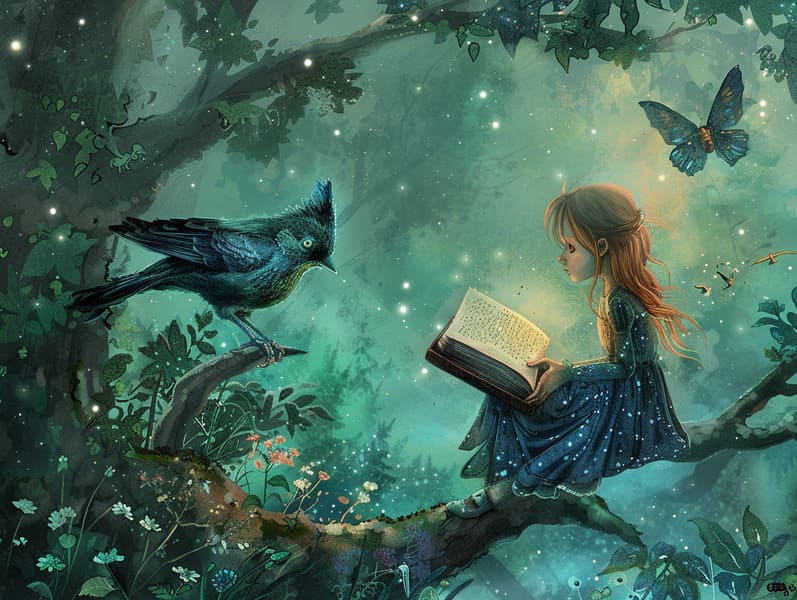The Formation of Mythical Fairy Tales with Its Steadfast Spell.
The Formation of Mythical Fairy Tales with Its Steadfast Spell.
Blog Article

Fairy tales for kids have enduring presence. These stories have been narrated from one generation to the next millennia before they were ever written down. They came from a variety of traditions, including Indigenous traditions. They were initially told among older generations, often carrying themes and messages relevant to the societal norms and beliefs of the time.
Jacob and Wilhelm Grimm, Jacob and Wilhelm Grimm, were among the first to compile and publish many of these beloved narratives. Their published works, "Grimm's Fairy Tales," included classics like "The Little Glass Slipper," "Hansel and Grethel," and "Snow-White and Rose-Red," which have since become pillars in the world of iconic fairy tales. Similarly, Andersen's magical tales, such as "The Mermaid," and "The Duckling's Story," have floated into hearts worldwide, guaranteeing their place in the pantheon of treasured fairy tales.
Even though they are old, these tales remain as important as ever, especially as children's bedtime stories. These magical stories are now available in multiple formats, including gorgeously illustrated books, magical animations, and digital fairy tales.
Their lasting presence can be credited to several charming aspects:
Valuable Lessons: Old fairy tales often convey important moral lessons. Stories like "The Wolf and the Liar" teach the virtue of truthfulness, while "The Tortoise and the Hare" emphasize the merits of persistence and humility. These narratives offer children clear distinctions between right and wrong, shaping their moral compass in a mild yet profound way.
Compassion and Insight: Traditional fairy tales frequently depict heroes facing difficulties and adversities, stimulating audiences to sympathize with their struggles and root for their triumphs. For instance, "Beauty's Beast" reveals the importance of seeing beyond the surface to see the true essence of a character, cultivating tenderness and insight.
Cultural Awareness: Many classic fairy tales are interwoven with the cultural contexts from which they arose. Learning from these narratives can provide delightful insights into different customs, fostering a sense of cultural understanding and comprehension.
Imagination and Creativity: The extraordinary elements in fairy tales—supernatural elements—spark children’s fantastical thinking. These tales lead readers to imaginary realms, boosting innovative ideas and a sense of enchantment that this site remains a lifetime.
Ancient fairy tales are not only captivating but also teaching. They serve as mesmerizing tools in fostering various cognitive and emotional skills in young ones. When fairy tales are narrated, they enhance language proficiency by showing new language and complicated sentence structures. This practice also nurtures auditory skills and mindfulness, as young ones follow the story, keen to see what happens next.
Furthermore, reflecting on the themes and characters of classic fairy tales can enhance thought processes and evaluative skills. Young readers are instructed to recognize patterns, foresee events, and get cause and effect. These debates also encourage young ones speak out their thoughts and feelings, boosting their emotional intelligence.
In today’s cyber age, the availability of web-based fairy tales has made these narratives more available than ever. Online platforms and programs offer large libraries of famous fairy tales that can be browsed or listened to anytime, anywhere. Fairy tales recited are particularly common, presenting an fascinating method for little ones to savor these entrancing tales. Read-aloud books and read-out-loud stories move characters and settings to life, often enhanced by charming musical scores and melodies that raise the storytelling journey.
The everlasting appeal of timeless fairy tales lies in their ability to change to modern days while staying true to their main lessons. Contemporary reinterpretations of these tales often present more inclusive protagonists and modern settings, making them relevant to today’s audience. However, the central morals of guts, humanity, and honesty remain unchanged, continuing to strike a chord with readers of all ages.
Traditional fairy tales also offer a sense of serenity and homeliness. They introduce a tidy narrative with a evident beginning, middle, and end, often finishing with the ending of conflicts and the triumph of good over bad. This reliability can be calming for young ones, providing a sense of firmness in an dynamic world.
Traditional fairy tales continue to bewitch and inform new generations, maintaining their mystique and significance in modern society. As bedtime stories for kids, they make available a perfect blend of enchantment and education, nourishing moral values, empathy, and creativity. The existence of internet fairy tales and the popularity of fairy tales voiced ratify that these classic tales remain acquirable to new generations.
By sustaining and passing on these narratives, we continue to laud the rich tapestry of lore and cultural heritage. Whether you are viewing a vibrantly illustrated book, exploring a digital collection, or playing an spoken story, the appeal of old fairy tales is always within reach. These stories remind us of the undying magic of tales and its ability to unite us across eras and regions.
Be it you are accessing a vibrantly illustrated book, discovering a online collection, or listening via an voice book, the attraction of old fairy tales is always within reach.
These stories convey of the unfading force of narratives and its ability to bring us together across centuries and lands, forming a connection that enchants and educates alike.